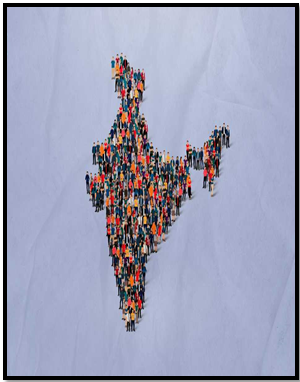DEMOGRAPHY AND DESTINY
News
Finance Minister Nirmala Sitharaman pledged in her speech to announce the 2024 budget that a committee will examine India’s population growth to make sure the country is on track to reach the Viksit Bharat goal by 2047.
Context
- India has become the most populous country in the world for the foreseeable future and it has happen nearly 50 years after the brutal implementation of the population control programme in 1976, which signals a shift in public discourse regarding the direction of India’s demographic transformation.
- However, it doesn’t seem to be the terrifying prospect it previously seemed to be; family planning has become the norm for all societal groups, and fertility has gradually decreased to the point where two parents are being replaced by two children. Furthermore, India has discovered that its population growth shouldn’t be a hindrance to its ongoing economic expansion and hence they require focus on multiple priorities.
Various Focus Priorities:
- Acknowledging the Demography:
- It is imperative to acknowledge that the demographic fate of India in 2047 has already been predetermined. The workforce of 2047 is already here and will not resemble the workforce of 2024 in the slightest;
- Currently, 23% of people are between the ages of 40 and 59, while 33% of people are between the ages of 20 and 29. However, by 2047, the younger population share will decline and the older working age population share will rise, making up a combined 28% of the total population;
- Way Forward: Beyond formal schooling, we need to invest in ongoing skill development and on-the-job training to make sure that this expanding proportion of middle-aged workers can meet the ever-changing demands of an increasingly digitally driven economy.
- Regional Variations in Productivity:
- Population aging will be more noticeable in southern, more developed states, just as fertility drop first appeared in these states;
- States will differ greatly in terms of dependency burden, which is measured as the number of people aged 15 to 59 who provide for children under 15 and the elderly population over 60;
- Demographer P M Kulkarni, for instance, projects that in 2021, 44 working-age individuals in Bihar supported 100 dependents, whilst in Tamil Nadu, 50 persons supported the same population. By 2051, this ratio will reverse, with 47 in Bihar and 24 in Tamil Nadu;
- To put it briefly, the productivity of workers in areas like Bihar, Uttar Pradesh, Madhya Pradesh, and Chhattisgarh which have long been seen as demographic laggards will determine the future of India’s elderly and children.
- Way Forward: We invest in the labour force in these states also we can decide on interstate allocations. It can be established by the 16th Finance Commission and also they can come up with the solution for the various challenges;
- Workforce Engagement:
- Women’s childcare responsibilities decrease as fertility decreases. Sociologist Sojin Yu along with others, analyzed National Family Health Survey data and found that, in 1993, the average mother took care of her children until they were five years old for roughly 14 years, but in 2021, that figure decreased to eight years.
- Time saved on child care hasn’t been put to better use that is, increased workforce engagement. If we don’t figure out how to make the workforce more welcoming to women, we’ll miss the chance to transform a demographic dividend into a gender dividend;
- Way Forward: Improving childcare accessibility could be one of the best strategies to increase women’s participation in the labour market, perhaps by combining Anganwadi with the Mahatma Gandhi National Rural Employment Guarantee Scheme in novel ways. There is no reason why the provision of childcare on a rotating basis under the supervision of a qualified early childhood educator cannot be a part of authorized MGNREGA works;
- Increasing Capacity of Old Age Population:
- The older population’s capacity must be increased for self-sufficiency due to a combination of an aging population and a decreasing number of children to take care of them;
- A variety of measures will be required, such as raising the retirement age, improving old age pension plans, and granting more flexibility in selling homes or land, which account for the majority of the wealth held by the elderly in India.
China’s Population Experience
- Concerns regarding the country’s population boom have historically dominated demographic discussions in India. However, the various lessons can be learned from China where they had paid a heavy price;
- China imposed a rigorous one-child policy in an attempt to rapidly reduce its population, pushing the country to a demographic cliff where the demands of an elderly population are starting to slow down economic growth;
- Increasing fertility has not been achieved by lifting the one-child limit and hence this implies that India should refrain from having a similar frantic response and let the decrease in fertility to proceed at a normal rate and if the demography be fate, let us gracefully adjust to it.
Conclusion
The multifaceted nature of these difficulties calls for the involvement of economists, sociologists, demographers, and public policy specialists. A positive feedback loop will be created when a highly qualified group is established to assess the difficulties presented by the demographic shift in tandem with the 16th Finance Commission and this committee’s recommendations will then influence government spending priorities.
Mains Question
India has learned that its increasing population shouldn’t impede its continued economic growth, thus they need to prioritize a number of issues. Analyze.
Source:




